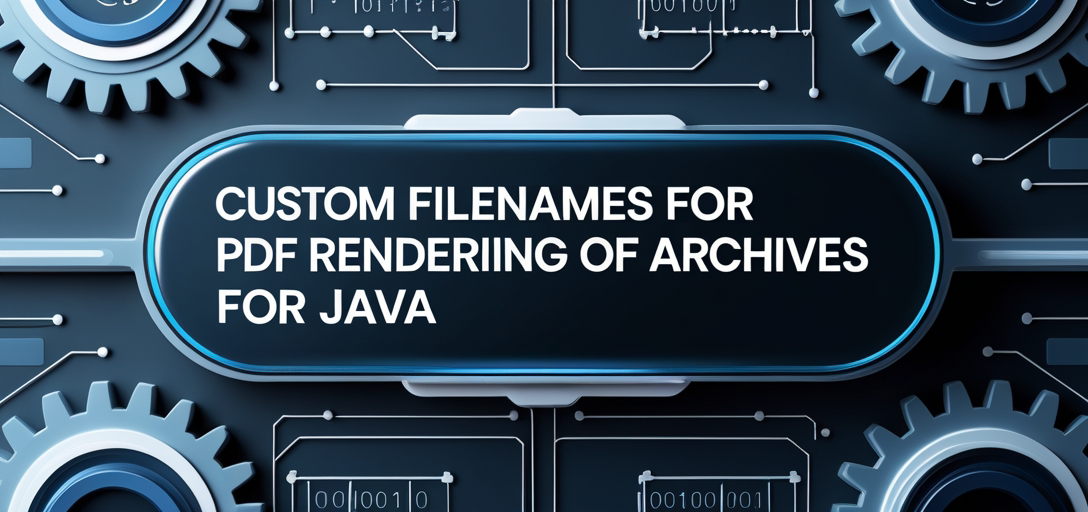Mastering GroupDocs.Viewer Java: Specify Custom Filenames When Rendering Archives to PDF
Introduction
Struggling with incorrect filenames during the conversion of archive files into PDF format? Whether it’s for branding or organizational needs, specifying custom filenames when converting archives ensures consistency and improves workflow efficiency. This tutorial guides you through using GroupDocs.Viewer for Java to customize output filenames during rendering.

What You’ll Learn:
- Setting up GroupDocs.Viewer for Java
- Rendering archive files into PDF with specified filenames
- Practical applications of custom filename features
- Best practices for performance optimization
Let’s dive in by setting up your environment and exploring the key features that make GroupDocs.Viewer a powerful tool for document rendering.
Prerequisites
Before we begin, ensure you have the following:
Required Libraries and Dependencies
- GroupDocs.Viewer for Java: Version 25.2 or later.
Environment Setup Requirements
- JDK (Java Development Kit) installed on your machine.
- An IDE like IntelliJ IDEA or Eclipse for developing Java applications.
Knowledge Prerequisites
- Basic understanding of Java programming.
- Familiarity with Maven as a build automation tool.
With these prerequisites in place, let’s proceed to setting up GroupDocs.Viewer for Java.
Setting Up GroupDocs.Viewer for Java
Installation via Maven
To integrate GroupDocs.Viewer into your project using Maven, add the following repository and dependency to your pom.xml file:
<repositories>
<repository>
<id>repository.groupdocs.com</id>
<name>GroupDocs Repository</name>
<url>https://releases.groupdocs.com/viewer/java/</url>
</repository>
</repositories>
<dependencies>
<dependency>
<groupId>com.groupdocs</groupId>
<artifactId>groupdocs-viewer</artifactId>
<version>25.2</version>
</dependency>
</dependencies>
License Acquisition Steps
- Free Trial: Access a fully functional trial version to evaluate features.
- Temporary License: Obtain for extended evaluation without limitations.
- Purchase: Acquire a license for commercial use.
Basic Initialization and Setup
After setting up Maven, initialize GroupDocs.Viewer with the following code snippet:
import com.groupdocs.viewer.Viewer;
// Initialize viewer object
try (Viewer viewer = new Viewer("YOUR_ARCHIVE_FILE_PATH")) {
// Configure options here
} catch (Exception e) {
e.printStackTrace();
}
Implementation Guide
Now, let’s focus on specifying filenames when rendering archives to PDFs.
Specifying Filename When Rendering Archive Files
This feature allows you to customize the output filename of your rendered PDF document. Here’s how:
Step 1: Define Output Directory and File Path
Start by setting up the output directory and file path using placeholders for easy customization:
import java.nio.file.Path;
// Define output directory and file path
Path outputDirectory = Path.of("YOUR_OUTPUT_DIRECTORY");
Path outputFilePath = outputDirectory.resolve("output.pdf");
Step 2: Initialize Viewer Object
Create a Viewer object with the archive file you wish to render:
import com.groupdocs.viewer.Viewer;
try (Viewer viewer = new Viewer("YOUR_DOCUMENT_DIRECTORY/SAMPLE_ZIP")) {
// Continue to next steps
} catch (Exception e) {
e.printStackTrace();
}
Step 3: Create PdfViewOptions
Set up PdfViewOptions to specify the rendering configurations:
import com.groupdocs.viewer.options.PdfViewOptions;
// Configure PDF view options
PdfViewOptions viewOptions = new PdfViewOptions(outputFilePath);
Step 4: Set Custom Filename
Use ArchiveOptions to set a custom filename for your rendered PDF document:
import com.groupdocs.viewer.options.FileName;
import com.groupdocs.viewer.options.ArchiveOptions;
// Specify the output PDF filename
viewOptions.getArchiveOptions().setFileName(new FileName("my_custom_filename.pdf"));
Step 5: Render Archive File to PDF
Finally, render your archive file using the specified options:
// Execute rendering process
viewer.view(viewOptions);
Troubleshooting Tips
- Ensure all paths are correctly set and directories exist.
- Verify that you have the correct version of GroupDocs.Viewer installed.
Practical Applications
Understanding how to specify filenames when rendering archives can be beneficial in various scenarios:
- Branding Consistency: Customize output filenames for branding purposes across multiple documents.
- Organizational Efficiency: Maintain a consistent naming convention for easier document management and retrieval.
- Automated Reporting: Generate reports with specific filenames automatically through scheduled tasks.
Performance Considerations
When working with GroupDocs.Viewer, consider the following to optimize performance:
- Utilize efficient memory management practices in Java.
- Monitor resource usage during rendering operations.
- Apply best practices for handling large document archives without affecting system performance.
Conclusion
In this tutorial, you’ve learned how to specify custom filenames when rendering archive files to PDF using GroupDocs.Viewer for Java. By following these steps, you can enhance your document management processes and ensure consistency across generated documents.
Next Steps
- Explore additional features of GroupDocs.Viewer.
- Experiment with different file types beyond archives.
Ready to implement this solution in your projects? Try it out today!
FAQ Section
Q: How do I install GroupDocs.Viewer for Java?
A: Use Maven and add the specified repository and dependency to your pom.xml.
Q: Can I specify filenames for other file formats besides PDF? A: Yes, similar options exist for different output formats supported by GroupDocs.Viewer.
Q: What if my rendered document filename is not as expected? A: Double-check the path definitions and ensure that all configurations are set correctly.
Q: How do I handle large archive files with GroupDocs.Viewer? A: Optimize memory usage and consider breaking down large files into smaller chunks for processing.
Q: Where can I find more resources on using GroupDocs.Viewer? A: Visit the GroupDocs documentation for comprehensive guides and API references.
Resources
- Documentation: GroupDocs Viewer Java Docs
- API Reference: GroupDocs Viewer Java Reference
- Download: GroupDocs Viewer Releases
- Purchase: Buy GroupDocs License
- Free Trial: Try GroupDocs Viewer
- Temporary License: Get Temporary License
- Support: GroupDocs Forum